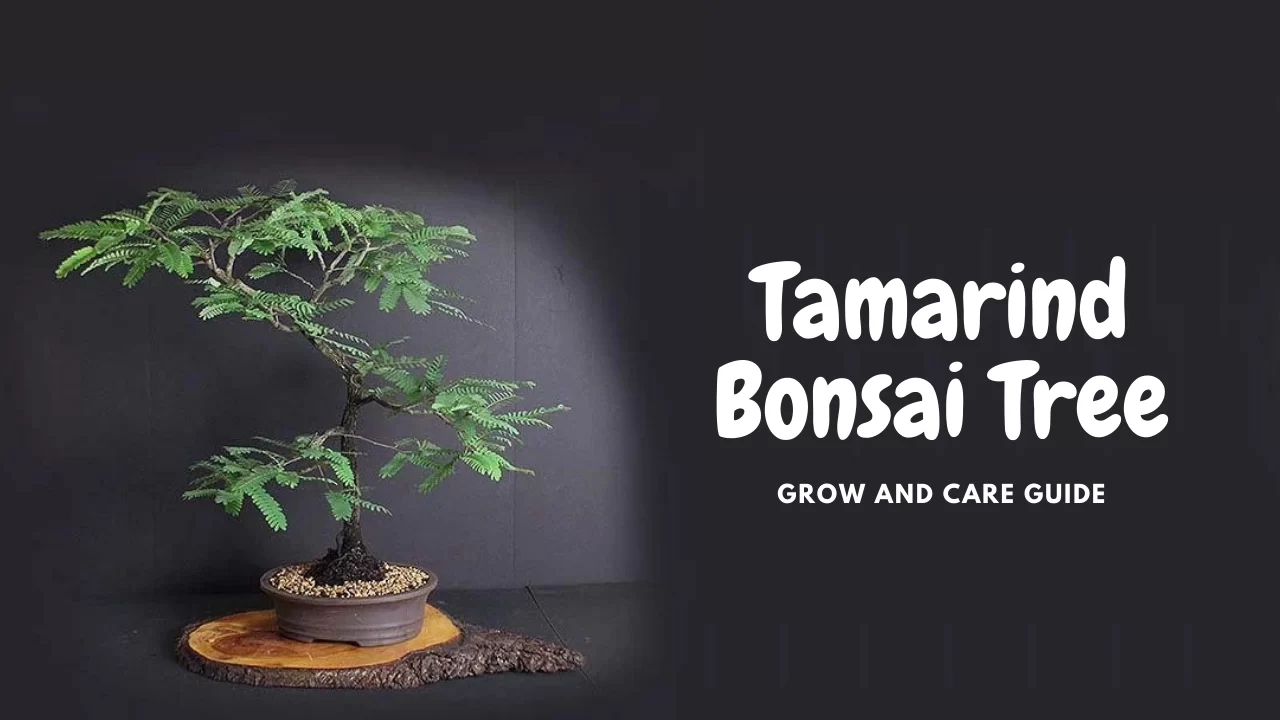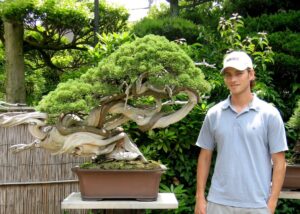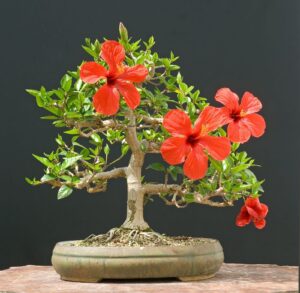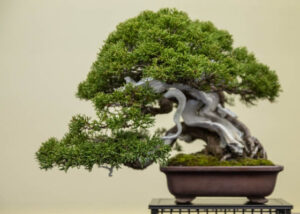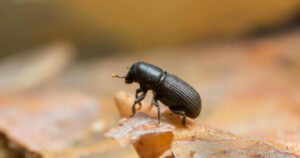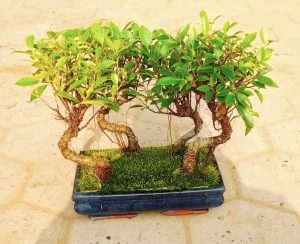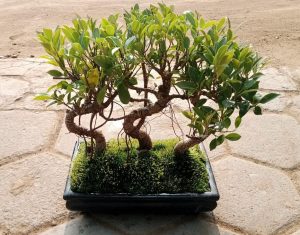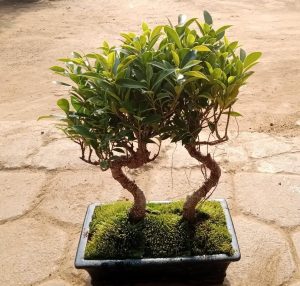Are you looking for a beautiful bonsai plant to keep in your home?
Don’t you worry my fellow plant companions, because I bring to you one of my personal favorites which is the Tamarind bonsai tree. The reason why I selected this tree is because of its attractive rough bark which enhanced the look of my home and made me feel like I am in one of my childhood’s dreams, a magical place with rough dense trees.
So, from my personal experience with tamarind bonsai trees, I will give you all the information you need to know about these trees if you are planning to bring one in your home. So, why are we waiting? Let’s check it out!
Before proceeding, let us first know what a tamarind tree is, why it is important and how to grow a Tamarind bonsai tree at home.
About Tamarind Bonsai Tree
Scientifically known as, Tamarindus indica which is a very beautiful plant, known for its shade and edible fruits and can be seen easily in any part of the world. It is a native tree of tropical regions, especially in Africa. Also, it grows wild in places with tropical climates.
These types of trees look like aged ones even though they are young. Their leaves are delicate, but the tree is very strong and could face heavy pruning. It is very easy to manipulate their roots and can be maintained easily, as this tree needs very little care.
Tamarind trees always tend to grow straight and so, it can be easy to prune and shape the tree. Tamarind flowers resemble small orchids and they are slightly fragrant. The flower buds are pink in color and they shed while flowering. The leaves of this tree are dense and pinnate, so it gives a feathery look. This type of tree lives longer for many years and grows very slowly.
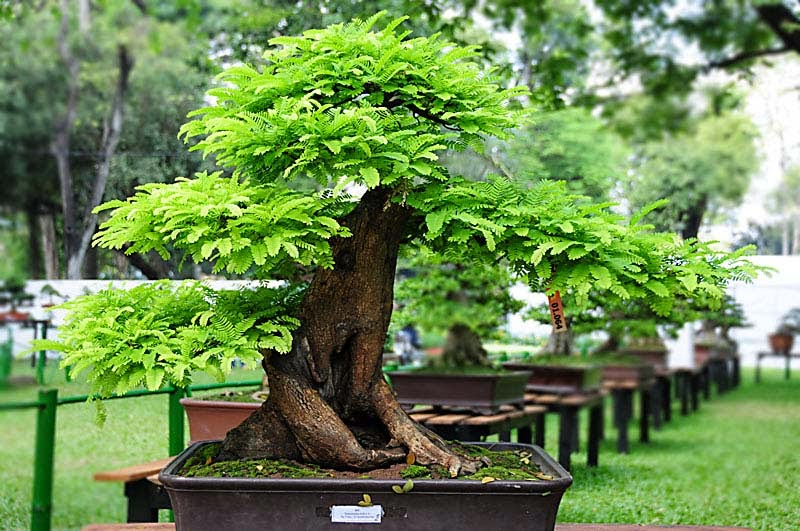
How To Grow Tamarind Bonsai Tree?
Although tamarind trees can be propagated through cutting, it is easy to grow them with their seeds. With the help of seeds, you don’t need to disturb a whole mature plant. So, now this question must be arising in your mind: how to grow a tamarind bonsai tree with seeds? So, let’s find out!
1. Growing tamarind with seeds
If you are going to plant tamarind with their seeds you should follow some steps that are mentioned below:
2. Soak the seeds
Soak the seeds in warm water for 10-12 hours. This helps to smoothen the seed coat and thus it can be easily removed. Also soaking helps to fasten the germination. Furthermore, make sure that the seeds are clean and do not have any pulp of tamarind fruit before you soak them.
3. Sow the seeds
Take a wide-mouthed pot with proper drainage holes and fill it with loamy soil. Now, sow the soaked seeds and water them regularly. It takes 10-15 days for germination of the seeds. And then leave the germinated seedlings in the same pot for 2-3 months. Also, don’t forget to fertilize it regularly to avoid pests and diseases.
4. Transfer it to pot
After 2-3 months, when the seedlings become strong and are ready to be repotted, then transfer them to a training pot to make it a bonsai tree. It is better to keep the training pot in the shade until a shoot starts to grow. Furthermore, it indicates that the roots are firm inside and then the pot should be placed in sunlight.
5. Making it a bonsai tamarind tree
To make the tree a bonsai, the plant needs to be wired and pruned regularly. Pruning helps in shaping and maintaining the bonsai structure. Also remember, if the pruning is not done properly, it may kill the plant.
Now you know the steps on how to grow a bonsai tree with seeds, so let us learn even more about the training process required for growing a tamarind bonsai tree.
Training Process Required To Grow A Bonsai Tamarind Tree
Training a bonsai tree is very difficult. You have to trim your plant regularly to get a perfect shape for your bonsai tamarind tree. Only professionals who know the art of pruning a bonsai can train such a tree. If you like to try it, then you have to be very cautious otherwise you will end up killing your tree.

How To Care For The Tamarind Bonsai Trees?
Although the tamarind bonsai tree is a low-care bonsai, you should know some tips on how to care and maintain the bonsai properly to make it strong and healthy living. Caring plays a vital role in maintaining a bonsai tree at home. Growing a bonsai in a pot depends on how much attention you give to it.
It will grow healthy, and beautiful and maintain its miniature shape for many years if you follow the following steps I have mentioned:
1. Watering the tree
One of the most important things that should never be neglected, while caring for a bonsai tree is watering. Do not let the soil dry. It is better to use a moisture meter in the beginning, to know your plant requirements.
Young plants need to be watered daily. You can reduce watering for your matured plant. Also, make sure that your plant gets enough water from time to time. If the water comes out of the drainage holes, it indicates that you have provided your plant with enough water, and excess water comes out of the drainage holes. Remember over-watering may lead to root rot. Also, this plant can survive in a drought, but you should not let the soil dry.
2. Giving proper sunlight
The Tamarind bonsai tree is one of the tropical plants which needs a lot of sunlight. It needs at least 4-6 hours of direct sunlight for better performance. Also, it can survive in very dry and hot climates.
3. Using high quality soil mix
Use high-quality soil mix for this tree. Tamarind bonsai trees never enjoy sitting in water, so make sure that the soil is well-draining.
4. Giving proper environment

In summer, spring, and fall
Tamarind grows well in spring and summer. It tends to absorb more sunlight in the growing season. So, it is better to put the bonsai tamarind tree outdoors in the summer, spring, and any season to get proper light and water. If you cannot leave it outdoors then put the plant beside the window sill.
In winter
As a tropical plant, tamarind cannot survive in cool climates. So, it is better to bring your bonsai tamarind tree indoors. Don’t leave your plant outside if the temperature falls below 45 degrees.
Furthermore, keep your bonsai tamarind tree on the window sill in the south direction, so that it allows the tree to get enough sunlight in the morning. Make sure that your bonsai tamarind tree is getting 4-6 hours of direct sunlight.
5. Giving a proper pruning
Pruning plays a vital role in maintaining a bonsai tamarind tree. It helps to keep your tree in miniature shape. Trim a little part of the new growth from time to time and cut it back up to the safest point.
Also, remember pruning should be done in small amounts, but regularly in time. This avoids the shock to the tree and helps to sustain the health of the tree. Always sanitize your pruning equipment before pruning, so that it will not get infected.
Let us learn more about pruning.
PRUNING LEAVES:
Leaves of your bonsai tree should be pruned regularly. Observe the new growth in leaves and gently pinch them all over the tree. Remember some part of the new growth should be left with the tree without trimming.
PRUNING BRANCHES:
The leftover new growth may form as a stem or branch and may grow oddly which may disturb the shape of your bonsai tamarind tree. Then just simply cut off the stem using sharp scissors. It is better not to pinch the stem with your hand, as it may get crushed. Also, this tree sustains heavy pruning, so you can prune a little more to maintain the shape.
PRUNING ROOTS:
Trimming the roots needs much experience and care. If you are a beginner, then take the help of some professionals or follow their books or blogs while pruning the bonsai tamarind tree.
Because, a small mistake you make while doing this, may cause severe loss and it cannot be compensated. So, it should be done very carefully only if the pot of the bonsai tamarind tree is filled with roots. Trim the new and delicate roots in the summer season, if necessary.
6. Repotting the plant from time to time
Repot your bonsai tamarind tree periodically. Usually, repotting is done while pruning roots and changing the soil to get a compact root system. Although some repotting rules say that the fruit-producing trees should be repotted every 2-4 years and so, it is better to repot your bonsai tree after checking the root growth in the pot.
If the pot is filled with extra roots, overlapping then it is time to repot. The best time to repot a bonsai tree is mid-summer.
7. Maintaining temperature and humidity
These bonsai trees grow well in humid and hot dry environments. But, take care of it in cold and freezing temperatures. Also, keep your bonsai tamarind tree indoors in winters. Put the pot in a bowl of water to keep it humid in dry conditions.
8. Fertilizing properly
If you are thinking of fertilizing your bonsai tamarind tree, then use only organic fertilizers (preferably acidic fertilizers). Use the fertilizer as per the given instructions. It is better to fertilize your plant twice a month, during the growing season, and once a month during winters to protect your plant in the beginning.
Feed your plant with acidic fertilizers mixed with water-soluble fertilizers for improving the acidic nature of the plant. Also, adding superphosphates to the above mixture will help the plant bloom.
9. Pest and diseases
Aphids and some insects are common pests that may attack your bonsai tamarind tree. Powdery mildew, which is formed due to fungus, may spread to some parts of the tree. If this happens, then just cut off the affected areas and prevent the spreading of it to the whole bonsai tree.
Also, you can use some pesticides to avoid these problems. Root rot is another problem that may bother you. Know your plant’s water needs and avoid overwatering.
FAQs:
Q1. Can we grow tamarind bonsai trees indoors?
Ans. Yes, we can grow them indoors, providing proper care and attention. Remember it may not flower during the growing time.
Q2. How long does it take for a tamarind plant to sprout?
Ans. It may take 10-15 days for a tamarind plant to sprout out from the seeds.
Q3. How many years does a tamarind tree take to grow?
Ans. If the plant is propagated through seeds, then it may take 7-8 years to grow into a mature tree and bear fruits. If it is propagated through the grafting process then it will take 4-5 years to grow into a tree.
Q4. What is the lifespan of a tamarind bonsai tree?
Ans. The lifespan of a tamarind bonsai tree is about 150 years if it is taken proper care.
Conclusion
Tamarind bonsai trees can be easily grown with proper care and attention. Let it grow into a mature adult tree and make your guest gasp from its appearance. Growing this tree in your home will also improve your gardening experience like me. You will feel happy while watching your bonsai tamarind tree growing beautifully slowly with time.
All you need to do is keep loving your tree.
I hope this article helps you to clear all your doubts you had before choosing this tree as a bonsai. If you like this article, please comment down below and let me know if you need information on different kinds of bonsai trees!
Related Articles
- Top 10 Bonsai Tree for Sale in India
- Unique Bonsai Gifts: Perfect for the Plant Enthusiast
- Bonsai Tree in a Terrarium – An Ultimate Guide To Build Bonsai Terrarium.
- Redwood Bonsai Care Guide: How to Grow, and Bonsai For Sale
- Growing Kale Indoor From Seeds With LED Grow Light
- Best Bonsai Plants to Grow in Summer

